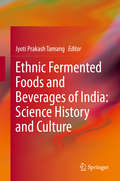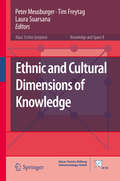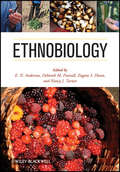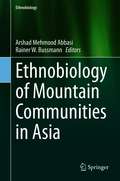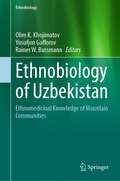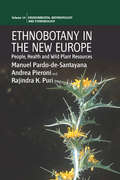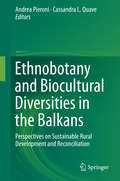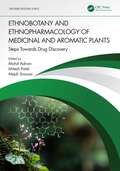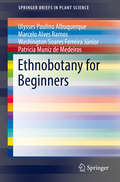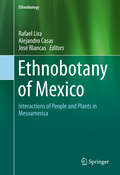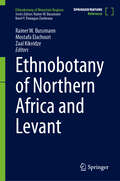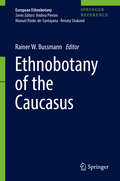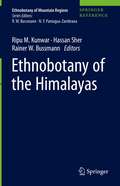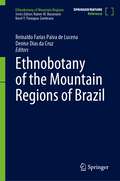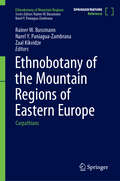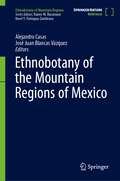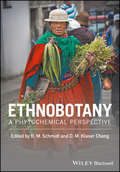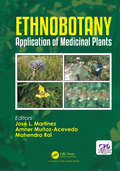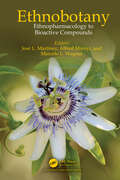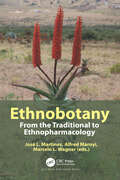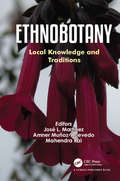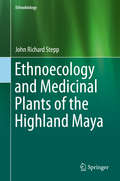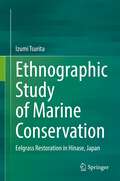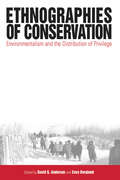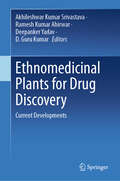- Table View
- List View
Ethnic Fermented Foods and Beverages of India: Science History and Culture
by Jyoti Prakash TamangThis book provides detailed information on the various ethnic fermented foods and beverages of India. India is home to a diverse food culture comprising fermented and non-fermented ethnic foods and alcoholic beverages. More than 350 different types of familiar, less-familiar and rare ethnic fermented foods and alcoholic beverages are traditionally prepared by the country’s diverse ethnic groups, and include alcoholic, milk, vegetable, bamboo, legume, meat, fish, and cereal based beverages. Most of the Indian ethnic fermented foods are naturally fermented, whereas the majority of the alcoholic beverages have been prepared using dry starter culture and the ‘back-sloping’ method for the past 6,000 years. A broad range of culturable and unculturable microbiomes and mycobiomes are associated with the fermentation and production of ethnic foods and alcoholic drinks in India. The book begins with detailed chapters on various aspects including food habits, dietary culture, and the history, microbiology and health benefits of fermented Indian food and beverages. Subsequent chapters describe unique and region-specific ethnic fermented foods and beverages from all 28 states and 9 union territories. In turn the classification of various ethnic fermented foods and beverages, their traditional methods of preparation, culinary practices and mode of consumption, socio-economy, ethnic values, microbiology, food safety, nutritional value, and process optimization in some foods are discussed in details with original pictures. In closing, the book addresses the medicinal properties of the fermented food products and their health benefits, together with corresponding safety regulations.
Ethnic and Cultural Dimensions of Knowledge
by Peter Meusburger Laura Suarsana Tim FreytagThis book presents theoretical and methodical discussions on local knowledge and indigenous knowledge. It examines educational attainment of ethnic minorities, race and politics in educational systems, and the problem of losing indigenous knowledge. It comprises a broad range of case studies about specifics of local knowledge from several regions of the world, reflecting the interdependence of norms, tradition, ethnic and cultural identities, and knowledge. The contributors explore gaps between knowledge and agency, address questions of the social distribution of knowledge, consider its relation to communal activities, and inquire into the relation and intersection of knowledge assemblages at local, national, and global scales. The book highlights the relevance of local and indigenous knowledge and discusses implications for educational and developmental politics. It provides ideas and a cross-disciplinary scientific background for scholars, students, and professionals including NGO activists, and policy-makers.
Ethnobiology
by E. N. Anderson D. Pearsall E. Hunn N. TurnerThe single comprehensive treatment of the field, from the leading members of the Society of Ethnobiology The field of ethnobiology—the study of relationships between particular ethnic groups and their native plants and animals—has grown very rapidly in recent years, spawning numerous subfields. Ethnobiological research has produced a wide range of medicines, natural products, and new crops, as well as striking insights into human cognition, language, and environmental management behavior from prehistory to the present. This is the single authoritative source on ethnobiology, covering all aspects of the field as it is currently defined. Featuring contributions from experienced scholars and sanctioned by the Society of Ethnobiology, this concise, readable volume provides extensive coverage of ethical issues and practices as well as archaeological, ethnological, and linguistic approaches. Emphasizing basic principles and methodology, this unique textbook offers a balanced treatment of all the major subfields within ethnobiology, allowing students to begin guided research in any related area—from archaeoethnozoology to ethnomycology to agroecology. Each chapter includes a basic introduction to each topic, is written by a leading specialist in the specific area addressed, and comes with a full bibliography citing major works in the area. All chapters cover recent research, and many are new in approach; most chapters present unpublished or very recently published new research. Featured are clear, distinctive treatments of areas such as ethnozoology, linguistic ethnobiology, traditional education, ethnoecology, and indigenous perspectives. Methodology and ethical action are also covered up to current practice. Ethnobiology is a specialized textbook for advanced undergraduates and graduate students; it is suitable for advanced-level ethnobotany, ethnobiology, cultural and political ecology, and archaeologically related courses. Research institutes will also find this work valuable, as will any reader with an interest in ethnobiological fields.
Ethnobiology of Mountain Communities in Asia (Ethnobiology)
by Arshad Mehmood Abbasi Rainer W. BussmannNatural resources and associated biological diversity provide the basis of livelihood for human population, particularly in the rural areas and mountain regions across the globe. Asia is home to the world's highest mountain regions including the Himalayas, Karakorum and Hindukush. These regions are renowned around the globe because of their unique beauty, climate, and biocultural diversity. Because of geoclimatic conditions, the mountains of Asia are medicinal and food plant diversity hot spots. The indigenous communities residing in the valleys of these mountains have their own culture and traditions, and have a long history of interaction with the surrounding plant diversity. Local inhabitants of these mountains areas possess significant traditional knowledge of plant species used as food, medicine, and for cultural purposes. So far, many workers have reported traditional uses of plant species from different regions of Asia including some mountain areas; however, there is not one inclusive document on the ethnobotany of mountains in Asia. This book provides a comprehensive overview on ethno-ecological knowledge and cross cultural variation in the application of plant species among various communities residing in the mountains of Asia; cross cultural variation in traditional uses of plant species by the mountain communities; high value medicinal and food plant species; and threats and conservation status of plant species and traditional knowledge. This book should be useful to researchers of biodiversity and conservation, ethnobiologists, ethnoecologists, naturalists, phytochemists, pharmacists, policy makers, and all who have a devotion to nature.
Ethnobiology of Uzbekistan: Ethnomedicinal Knowledge of Mountain Communities (Ethnobiology)
by Rainer W. Bussmann Olim K. Khojimatov Yusufjon GafforovNatural resources and associated biological diversity provide the basis of livelihood for humans, particularly in rural areas and mountain regions around the world. Over centuries, indigenous peoples, traditional societies and local communities have developed their own specific knowledge regarding plant use, management, and conservation. The history of plant use by humans as food and to treat diverse ailments dates back to ancient civilizations. Even though the advent of allopathic medicine has somehow minimized the role of medicinal plants in favor of synthetic drugs, a number of modern drug discoveries have been based on medicinal plants used by indigenous peoples. Ethnobiology is the burgeoning interdisciplinary scientific field which covers all sorts of interactions between plants and people, and Central Asia is recognized as a plant diversity hot spot. The mountains and valleys of this region are rich in unique medicinal and food plant species. Local communities residing in the mountain regions of Central Asia possess unique knowledge of surrounding resources, which is the result of many years of interaction with and selection of the most desirable and pervasive plant species present. In this context, this book provides comprehensive information on cross-culture variation in the traditional uses of plants, fungi, and animal species as food, medicine, and for cultural purposes among the diverse communities of Uzbekistan. The key areas of focus include plant diversity in Uzbekistan, cross cultural variation in traditional uses of plant species, high-value medicinal and food plant species, and threats and conservation status of plant species and traditional knowledge
Ethnobotany In The New Europe: People, Health and Wild Plant Resources (Environmental Anthropology and Ethnobiology #14)
by Andrea Pieroni Manuel Pardo-de-Santayana Rajindra K. PuriThe study of European wild food plants and herbal medicines is an old discipline that has been invigorated by a new generation of researchers pursuing ethnobotanical studies in fresh contexts. Modern botanical and medical science itself was built on studies of Medieval Europeans' use of food plants and medicinal herbs. In spite of monumental changes introduced in the Age of Discovery and Mercantile Capitalism, some communities, often of immigrants in foreign lands, continue to hold on to old recipes and traditions, while others have adopted and enculturated exotic plants and remedies into their diets and pharmacopoeia in new and creative ways. Now in the 21st century, in the age of the European Union and Globalization, European folk botany is once again dynamically responding to changing cultural, economic, and political contexts. The authors and studies presented in this book reflect work being conducted across Europe's many regions. They tell the story of the on-going evolution of human-plant relations in one of the most bioculturally dynamic places on the planet, and explore new approaches that link the re-evaluation of plant-based cultural heritage with the conservation and use of biocultural diversity.
Ethnobotany and Biocultural Diversities in the Balkans
by Andrea Pieroni Cassandra L. QuaveThis volume addresses recent and ongoing ethnobotanical studies in the Balkans. The book focuses on elaborating the relevance of such studies for future initiatives in this region, both in terms of sustainable and peaceful (trans-regional, trans-cultural) rural development. A multi-disciplinary viewpoint is utilized, with an incorporation of historical, ethnographic, linguistic, biological, nutritional and medical perspectives. The book is also authored by recognized scholars, who in the last decade have extensively researched the Balkan traditional knowledge systems as they pertain to perceptions of the natural world and especially plants. Ethnobotany and Biocultural Diversities in the Balkans is the first ethnobotany book on one of the most biologically and culturally diverse regions of the world and is a valuable resource for both scholars and students interested in the field of ethnobotany.
Ethnobotany and Ethnopharmacology of Medicinal and Aromatic Plants: Steps Towards Drug Discovery (Exploring Medicinal Plants)
by Mohd Adnan Mitesh Patel Mejdi SnoussiMedicinal and aromatic plants are beneficial to human health. Plant-derived molecules possess biological activities that can be used to prevent many infectious diseases and metabolic disorders. Ethnobotany and Ethnopharmacology of Medicinal and Aromatic Plants summarizes techniques and methods used to study the biological activities of plant-derived extracts and compounds to study ethnobotanical and ethnopharmacological features of medicinal and aromatic plants. This book: Includes computational approaches to study the pharmacological properties of biomolecules in medicinal and aromatic plants. Details methods in ethnopharmacology including chromatographical and analytical techniques. Demonstrates trends in sustainable use and management of medicinal and aromatic plants. Features information on databases and tools used in computational phytochemistry for drug designing and discovery. Elucidates the importance of phytochemicals as immunomodulators in herbal drug development including their nanoformulations. A volume in the Exploring Medicinal Plants series, Ethnobotany and Ethnopharmacology of Medicinal and Aromatic Plants will be of interest to those working with plant extracts, including botanists and ethnobotanists, pharmacologists and ethnopharmacologists, as well as scientists and researchers interested in natural compounds and their potential applications.
Ethnobotany for Beginners
by Ulysses Paulino Albuquerque Patrícia Muniz De Medeiros Marcelo Alves Ramos Washington Soares Ferreira JúniorDesigned for new scholars, this book features a quick and easy-to-read discussion of ethnobotany along with its major developments. The language is clear and concise, objective and straightforward, and structured to lead the reader from the beginning of this science to the most recent developments. While there are some books on ethnobotany, mainly dealing with methods, this book covers the topic in an introductory and comprehensive text that prepares the reader for more advanced study of ethnobotany.
Ethnobotany of Mexico
by Alejandro Casas Rafael Lira José BlancasThis book reviews the history, current state of knowledge, and different research approaches and techniques of studies on interactions between humans and plants in an important area of agriculture and ongoing plant domestication: Mesoamerica. Leading scholars and key research groups in Mexico discuss essential topics as well as contributions from international research groups that have conducted studies on ethnobotany and domestication of plants in the region. Such a convocation will produce an interesting discussion about future investigation and conservation of regional human cultures, genetic resources, and cultural and ecological processes that are critical for global sustainability.
Ethnobotany of Northern Africa and Levant (Ethnobotany of Mountain Regions)
by Rainer W. Bussmann Zaal Kikvidze Mostafa ElachouriResearch in recent years has increasingly shifted away from purely academic research, and into applied aspects of the discipline, including climate change research, conservation, and sustainable development. It has by now widely been recognized that “traditional” knowledge is always in flux and adapting to a quickly changing environment. Trends of globalization, especially the globalization of plant markets, have greatly influenced how plant resources are managed nowadays. While ethnobotanical studies are now available from many regions of the world, no comprehensive encyclopedic series focusing on the worlds mountain regions is available in the market. Scholars in plant sciences worldwide will be interested in this dynamic content. The field (and thus the market) of ethnobotany and ethnopharmacology has grown considerably in recent years. Student interest is on the rise, attendance at professional conferences has grown steadily, and the number of professionals calling themselves ethnobotanists has increased significantly. Various societies of such professionals include the Society for Economic Botany, the International Society of Ethnopharmacology, the Society of Ethnobiology, the International Society for Ethnobiology, and many regional and national societies in the field that currently have thousands of members. Growth has been most robust in BRIC countries.The objective of this new MRW on Ethnobotany of Mountain Regions is to take advantage of the increasing international interest and scholarship in the field of mountain research. We anticipate including the best and latest research on a full range of descriptive, methodological, theoretical, and applied research on the most important plants for each region. Each contribution will be scientifically rigorous and contribute to the overall field of study.
Ethnobotany of the Caucasus
by Rainer W. BussmannThe Caucasus MRW (online and print) Volume will cover this European Macroregion. The content will focus on the ethnobotany of wild plants in this Macroregion and it will be first developed as an online site and, later, when all of the planned topics have been covered for this specific volume, printed in a hard copy version. The online site will remain live and be available for updates (with new monographs [if not covered initially due to lack of research]). The content will be divided into sections covering countries (or groups of countries), based on plant diversity and not necessarily political or national boundaries. The Caucasus volume will have an Introduction (4,000-6,000 words); 50 200 plant monographs (10 to maximum 50 monographs per country) with each monograph having a length of ~1,500 words (with references), plus 2-4 photographs. To further define the content, the plant monographs will be divided into five major categories (food; medicine/cosmetic; veterinary; handicraft plants; and ritual/folkloric uses) and include notes. The number of the monographs in every category will be negotiated depending on the advances of the ethnobotanical research in each specific country, or group of countries. The main criteria for the inclusion of a given plant will be its cultural salience within a given country (assessed by the Volume Editor). References will be given at the end of the Introduction and each monograph.
Ethnobotany of the Himalayas (Ethnobotany of Mountain Regions)
by Rainer W. Bussmann Ripu M. Kunwar Hassan SherResearch in recent years has increasingly shifted away from purely academic research, and into applied aspects of the discipline, including climate change research, conservation, and sustainable development. It has by now widely been recognized that “traditional” knowledge is always in flux and adapting to a quickly changing environment. Trends of globalization, especially the globalization of plant markets, have greatly influenced how plant resources are managed nowadays. While ethnobotanical studies are now available from many regions of the world, no comprehensive encyclopedic series focusing on the worlds mountain regions is available in the market. Scholars in plant sciences worldwide will be interested in this website and its dynamic content.The field (and thus the market) of ethnobotany and ethnopharmacology has grown considerably in recent years. Student interest is on the rise, attendance at professional conferences has grown steadily, and the number of professionals calling themselves ethnobotanists has increased significantly (the various societies, like the Society for Economic Botany, the International Society of Ethnopharmacology, the Society of Ethnobiology, and the International Society for Ethnobiology currently have thousands of members). Growth has been most robust in BRIC countries.This new MRW on Ethnobotany of the Himalayas takes advantage of the increasing international interest and scholarship in the field of mountain research. It includes the best and latest research on a full range of descriptive, methodological, theoretical, and applied research on the most important plants in the Himalayas. Each contribution is scientifically rigorous and contributes to the overall field of study.
Ethnobotany of the Mountain Regions of Brazil (Ethnobotany of Mountain Regions)
by Reinaldo Farias Paiva de Lucena Denise Dias da CruzResearch in recent years has increasingly shifted away from purely academic research, and into applied aspects of the discipline, including climate change research, conservation, and sustainable development. It has by now widely been recognized that “traditional” knowledge is always in flux and adapting to a quickly changing environment. Trends of globalization, especially the globalization of plant markets, have greatly influenced how plant resources are managed nowadays. While ethnobotanical studies are now available from many regions of the world, no comprehensive encyclopedic series focusing on the worlds mountain regions is available in the market. Scholars in plant sciences worldwide will be interested in this website and its dynamic content. The field (and thus the market) of ethnobotany and ethnopharmacology has grown considerably in recent years. Student interest is on the rise, attendance at professional conferences has grown steadily, and the number of professionals calling themselves ethnobotanists has increased significantly (the various societies (Society for Economic Botany, International Society of Ethnopharmacology, Society of Ethnobiology, International Society for Ethnobiology, and many regional and national societies in the field currently have thousands of members). Growth has been most robust in BRIC countries.The objective of this new MRW on Ethnobotany of Mountain Regions is to take advantage of the increasing international interest and scholarship in the field of mountain research. We anticipate including the best and latest research on a full range of descriptive, methodological, theoretical, and applied research on the most important plants for each region. Each contribution will be scientifically rigorous and contribute to the overall field of study.
Ethnobotany of the Mountain Regions of Eastern Europe: Carpathians (Ethnobotany of Mountain Regions)
by Rainer W. Bussmann Zaal Kikvidze Narel Y. Paniagua-ZambranaNatural resources and associated biological diversity provide the basis of livelihood for humans, particularly in the rural areas and mountain regions around the world. Over centuries, indigenous peoples, traditional societies, and local communities have developed their own specific knowledge regarding plant use, management, and conservation. The history of plant use by humans as food and to treat diverse ailments dates back to ancient civilizations. Even though the advent of allopathic medicine has somehow minimized the role of medicinal plants in favor of synthetic drugs, a number of modern drug discoveries have been based on medicinal plants used by indigenous peoples. Ethnobiology is the burgeoning interdisciplinary scientific field, which covers all types of interactions between plants and people, and Eastern Europe is recognized as a plant diversity hot spot. This new Major Reference Work on the Ethnobotany of Mountain Regions of Eastern Europe: Carpathians covers in detail the mountains and vallies of this region, which are known to be rich in unique medicinal and food plant species. Local communities residing in the mountain regions of Eastern Europe possess unique knowledge of surrounding resources, which is the result of many years of interaction with and selection of the most desirable and pervasive plant species present. In this context this major reference work provides comprehensive information on cross-culture variation in the traditional uses of plants as food, medicine, and for cultural purposes among these diverse communities residing in Eastern Europe. The key areas of focus include plant diversity in the Carpathians, cross cultural variation in traditional uses of plant species by these communities, high-value medicinal and food plant species, and threats and conservation status of plant species and traditional knowledge.
Ethnobotany of the Mountain Regions of Mexico (Ethnobotany of Mountain Regions)
by Alejandro Casas José Juan Blancas VázquezResearch in recent years has increasingly shifted away from purely academic research, and into applied aspects of the discipline, including climate change research, conservation, and sustainable development. It has by now widely been recognized that “traditional” knowledge is always in flux and adapting to a quickly changing environment. Trends of globalization, especially the globalization of plant markets, have greatly influenced how plant resources are managed nowadays. While ethnobotanical studies are now available from many regions of the world, no comprehensive encyclopedic series focusing on the worlds mountain regions is available in the market. Scholars in plant sciences worldwide will be interested in this website and its dynamic content. The field (and thus the market) of ethnobotany and ethnopharmacology has grown considerably in recent years. Student interest is on the rise, attendance at professional conferences has grown steadily, and the number of professionals calling themselves ethnobotanists has increased significantly (the various societies (Society for Economic Botany, International Society of Ethnopharmacology, Society of Ethnobiology, International Society for Ethnobiology, and many regional and national societies in the field currently have thousands of members). Growth has been most robust in BRIC countries.The objective of this new MRW on Ethnobotany of Mountain Regions is to take advantage of the increasing international interest and scholarship in the field of mountain research. We anticipate including the best and latest research on a full range of descriptive, methodological, theoretical, and applied research on the most important plants for each region. Each contribution will be scientifically rigorous and contribute to the overall field of study.
Ethnobotany: A Phytochemical Perspective
by Barbara M. Schmidt Diana M. Klaser ChengEthnobotany: A Phytochemical Perspective explores the chemistry behind hundreds of plant medicines, dyes, fibers, flavors, poisons, insect repellants, and many other uses of botanicals. Bridging the gap between ethnobotany and chemistry, this book presents an introduction to botany, ethnobotany, and phytochemistry to clearly join these fields of study and highlight their importance in the discovery of botanical uses in modern industry and research. Part I. Ethnobotany, explores the history of plant exploration, current issues such as conservation and intellectual property rights, and a review of plant anatomy. An extensive section on plant taxonomy highlights particularly influential and economically important plants from across the plant kingdom. Part II. Phytochemistry, provides fundamentals of secondary metabolism, includes line drawings of biosynthetic pathways and chemical structures, and describes traditional and modern methods of plant extraction and analysis. The last section is devoted to the history of native plants and people and case studies on plants that changed the course of human history from five geographical regions: Africa, the Americas, Asia, Europe, and Ocean. Throughout the entire book, vivid color photographs bring science to life, capturing the essence of human botanical knowledge and the beauty of the plant kingdom.
Ethnobotany: Application of Medicinal Plants
by Mahendra Rai José L. Martinez Amner Muñoz-AcevedoEthnobotany includes the traditional use of plants in different fields like medicine and agriculture. This book incorporates important studies based on ethnobotany of different geographic zones. The book covers medicinaland aromatic plants, ethnopharmacology, bioactive molecules, plants used in cancer, hypertension, disorders of the central nervous system, and also as antipsoriatic, antibacterial, antioxidant, antiurolithiatic. The book will be useful for a diverse group of readers including plant scientists, pharmacologists, clinicians, herbalists, natural therapy experts, chemists, microbiologists, NGOs and those who are interested in traditional therapies.
Ethnobotany: Ethnopharmacology to Bioactive Compounds
by José L. Martinez Alfred Maroyi Marcelo L. WagnerEthnobotany: Ethnopharmacology to Bioactive Compounds comprises of carefully selected studies focusing on the importance of ethnobotanical data as an effective approach towards the discovery of novel ethnopharmacological properties and bioactive compounds that characterize herbal products, pharmaceutical drugs and medicinal plants. This book incorporates therapeutic, nutritional, phytochemistry and pharmacological properties of medicinal plants, mechanisms of action and clinical trials of bioactive compounds as well as the molecular basis of the bioactive compounds from the perspective of modern phytochemistry. This book will be useful for a diverse group of readers including students, botanists, pharmacists, chemists, herbalists and those researchers interested in ethnobotany and ethnopharmacology.
Ethnobotany: From the Traditional to Ethnopharmacology
by José L. Martinez Alfred Maroyi Marcelo L. WagnerIn this book we present recent studies that have been carried out on some widely used medicinal plants. The need for new and alternative treatments stem from the lack of efficiency of existing remedies for certain illnesses. We have compiled information that may be useful to researchers in their quest to develop new drugs.
Ethnobotany: Local Knowledge and Traditions
by Mahendra Rai Jose L. Martinez Amner Munoz-AcevedoEthnobotany: Local Knowledge and Traditions discusses various plants that have actually been used in traditional medicine for a specific ailment. It desribes the biological effectiveness (activities) related to each "sickness" which have been scientifically verified. This book will also discuss the bioactivities established/determined that are promising and have potential. Finally, this book will be an appropriate consultation tool for scientists/professionals/experts such as ethnobotanists, botanists, cell/molecular biologists, chemists, pharmacists, pharmacologists, environmentalists/ecologists.
Ethnoecology and Medicinal Plants of the Highland Maya (Ethnobiology Ser.)
by John Richard SteppPlants play a central role in human existence. Medicinal plants, in particular, have allowed for the continued survival of the human species. This book, based on over a decade of research in Southern Mexico with the Highland Maya, explores the relationship between medicinal plants, traditional ecological knowledge and the environment. The biodiversity of the region remains among the highest in the world, comprising more than 9000 plant species. Over 1600 employed for medicinal uses and knowledge for approximately 600 species is widespread. Medicinal plants play an overwhelmingly primary role in the daily health care of the Highland Maya. Three principal objectives are addressed: 1) identifying which medicinal plants are used; 2) determining the role of environmental variation on use and selection of medicinal plants; and 3) identifying which habitats are preferred for medicinal plant procurement. Findings demonstrate the overwhelming importance of human modified environments for medicinal plants. Explanations are presented from human ecology and biochemical ecology. Implications for conservation, health and the environment are discussed.
Ethnographic Study of Marine Conservation: Eelgrass Restoration in Hinase, Japan
by Izumi TsuritaThis book explores the nature of marine conservation based on the case study of Hinase, a fishing village in Okayama, Japan. It focuses on the fishers’ self-motivated eelgrass restoration activity which has been continued for more than 30 years. This activity in Hinase recently attracted international attention as a case under the name “Satoumi” and “Marine Protected Areas” in several governmental reports, but detailed information, such as the historical background and social structure of Hinase, has not yet been analyzed. This book, therefore, fulfills this gap by providing its ethnographic information. In addition, this book offers some points for critical thinking by concluding that marine conservation activities cannot always be evaluated or arranged under the standardized approach with limited time and space. This viewpoint reaffirms the importance of local initiative and highlights the value of qualitative research to seek the way forward for promising marine conservation. This book is suitable for an academic audience in the field of social sciences, such as applied anthropology, as well as ecologists, government officials, environmentalists, and citizens who are interested or engaged in environmental issues or natural resource management.
Ethnographies Of Conservation
by David G. AndersonAnthropologists know that conservation often disempowers already under-privileged groups, and that it also fails to protect environments. Through a series of ethnographic studies, this book argues that the real problem is not the disappearance of "pristine nature" or even the land-use practices of uneducated people. Rather, what we know about culturally determined patterns of consumption, production and unequal distribution, suggests that critical attention would be better turned on discourses of "primitiveness" and "pristine nature" so prevalent within conservation ideology, and on the historically formed power and exchange relationships that they help perpetuate.
Ethnomedicinal Plants for Drug Discovery: Current Developments
by Akhileshwar Kumar Srivastava Ramesh Kumar Ahirwar Deepanker Yadav D. Guru KumarThis book explains the translational aspects of ethnomedicinal plants of different geographical regions including India by explaining the medicinal properties against several diseases, genomic evolution in changing environments, metabolic profiling for biomarker discovery, the role of non-coding RNA in the synthesis of secondary metabolites, genome-wide transcriptome profiling, application of pluripotent stem cells for drug discovery, the importance of high-throughput omics, and genome-editing techniques. In addition, some of the chapters have been designed to describe the role of artificial intelligence, plant database, and network-based drug discovery to explore the medicinal importance of compounds as well as challenges and opportunities in drug discovery from ethnomedicinal plants. The book serves as a great source of information for the students, researchers/scientists of diverse fields such as pharmacognosy, plant physiologists, biotechnologists, and pharmaceutical scientists etc., working in the areas of phytotherapy from ethnomedicinal plants.
